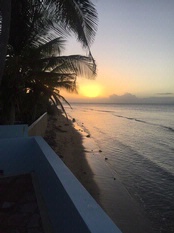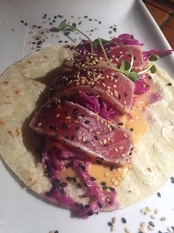 years we have left our home in Baltimore and headed to Vieques, a warm and sunny island that lies about 20 miles east of the Puerto Rican mainland.
years we have left our home in Baltimore and headed to Vieques, a warm and sunny island that lies about 20 miles east of the Puerto Rican mainland.
Vieques is small, roughly 20 miles long by 4.5 miles wide, and blissfully under-developed. The only time in recent history that the world has paid much attention to Vieques was, most recently, in 2017 when Hurricane Maria hit Puerto Rico, and a few years earlier when there was a series of protests against the U.S. Navy for using part of Vieques for bombing practice and as a testing ground for armaments. When the Navy finally left the island in 2003, that land became a beachfront wildlife refuge, although much of it is still off-limits to visitors. Despite efforts to clean the place up, unexploded bombs, rockets and other munitions still litter the eastern half of the island and surrounding beaches. About 11 square miles of land has been re-opened, but it seems that some of this region will remain permanently closed.
When we visited Vieques last year shortly after Hurricane Maria wreaked so much damage on Puerto Rico, electricity was available only to the few residences and businesses that were powered by generators. With electricity mostly restored things have greatly improved in the past twelve months, although much of the island still relies on generators to provide power. We tourists barely notice the occasional glitches, but for the 9,000-10,000 Puerto Ricans living in Vieques this is one of many problems they still have to contend with.
But losing power now and then or even stepping on unexploded munitions are not among my worries. My concern about Vieques is generally more about the wine, or rather the lack of wine. The best restaurants on the island have excellent and mostly modestly priced food, but their wine lists (when such a thing even exists) tend to be limited. Take El Locale for example, a small and charming restaurant that opened earlier this year in Isabel Segunda, the friendly little town where we rented a house. El Locale is tucked into a lovely open-air courtyard tucked behind a tall white wall just at the end of Isabel’s main street. The menu here is small but full of temptations, the list of beers is short but succinct, and the wine list is, well, limited (only anonymous “White Wine” and “Red Wine” appear on the menu, $9 each). But what El Locale also offers is a small but serious list of cocktail options, each of them mercifully limited to only two or three two principal ingredients (personally, I tend to prefer cocktails that are not teeming with a multitude of elixirs). I settle on “El Pilon”–gin, lime juice, guava, simple syrup and mint, which proves to be an outstanding libation, with fruit, sweetness and acidity in perfect balance, and the fresh guava adding a delicious undercurrent of flavor. Somewhat to my surprise, the cocktail is also a felicitous accompaniment to my meal: slices of skirt steak lying on a pillow of “fufu cubano,” a traditional Cuban offering based on mashed green plantains seasoned with garlic, olive oil and chicharrones. From this experience I realize that wine may not be the only beverage to enjoy with steak. (El Locale, 51 Antonio Mellado, 787 398-2039.)
On every visit to Vieques we go to Coqui Fire as many times as possible to savor the awesome Mexican food prepared by Jimmy “Hot Sauce” Cochran, whose wife, the charlming Slovakian-born Katerina, works the front of the  house. I’m crazy about Coqui Fire’s Tuna Taco (pan seared rare tuna with tendrils of red cabbage and flavorful sesame aioli, served on a small, delicate flour tortilla). The Big Kahuna Burrito is uniquely satisfying, as is Blackened Shrimp served over Mexican grits and coconut mole. Take one bite of the Carnitas–pork shoulder marinated in chilies and papaya juice until meltingly tender, served with corn or flour tortillas and house-made chutney–and you’ll immediately understand why it has long been Coqui Fire’s most popular dish. The modest wine list at Coqui Fire is limited to a small number of inexpensive white and red wines. Cocktail options include two top-notch Margaritas, the refreshingly straightforward Golden Margarita, and Coqui Fire Margarita, which is distinguished by a savory blast of hot sauce. (Coqui Fire, Calle Carlos Lebrum, 787 741-0401).
house. I’m crazy about Coqui Fire’s Tuna Taco (pan seared rare tuna with tendrils of red cabbage and flavorful sesame aioli, served on a small, delicate flour tortilla). The Big Kahuna Burrito is uniquely satisfying, as is Blackened Shrimp served over Mexican grits and coconut mole. Take one bite of the Carnitas–pork shoulder marinated in chilies and papaya juice until meltingly tender, served with corn or flour tortillas and house-made chutney–and you’ll immediately understand why it has long been Coqui Fire’s most popular dish. The modest wine list at Coqui Fire is limited to a small number of inexpensive white and red wines. Cocktail options include two top-notch Margaritas, the refreshingly straightforward Golden Margarita, and Coqui Fire Margarita, which is distinguished by a savory blast of hot sauce. (Coqui Fire, Calle Carlos Lebrum, 787 741-0401).
When we cooked at home, we shopped for wines in the two main grocery stores in Isabel (there are no wine shops here). White wine options tend to be limited, though we were lucky to uncover a couple of bottles each of Cavit Pinot Grigio and El Coto, a white blend from Rioja made from Viura, Verdjo and Sauvignon Blanc. With decent red wines somewhat more prevalent, we picked up a bottle each of Alamos Red Blend and Santa Julia Malbec.
As it turned out, we should have bought more wine. Since most food and virtually all bottled beverages are brought to the island by boat, provisions sometimes get low. Towards the end of our week in Vieques both grocery stores had pretty much run out of white wines altogether, and the selection of remaining reds was not particularly tempting. What to do? Well, to paraphrase an old saying, when the going gets tough the tough get going for rum.
Rum (“Ron” in Spanish) has played a significant role in Puerto Rico’s economy since the early 16th century as a by-product of the sugar industry. For a number of reasons, including falling prices, in the 1920s and ‘30s the sugar industry on which Vieques was completely dependent, declined, forcing many locals to leave the island. The sugar cane has mostly disappeared, but rum is produced in scores of distilleries around the main island of Puerto Rico. While no rum has yet been made in Vieques, Crab Island Rum, a local distillery producing quality artisanal rum is poised in the wings, set soon to open.
Meanwhile, among our options are Bacardi (the most popular rum in the word), made in an enormous distillery just across the bay from San Juan, and Don Q (named for Don Quixote), which has been operating here since 1820 and is apparently a favorite of local aficionados. Captain Morgan, a Seagram product, is the fourth largest brand in the USA (and the 11th largest in the world). The rum we fell in love with this year is Don Barrilito, a smooth, savory and dry rum graced by a little funkiness and a light whisky-ish oakiness on the generous finish. Don Barrilito is made in small batches, with no artificial ingredients or coloring. We’ve enjoyed this rum with fresh lime and a little tonic with a variety of foods (grilled ribs and burgers, for example) or on its own with a single ice cube as a soothing nightcap. All of which is a reminder that while wine may be the most versatile, diverse, pleasurable and food-friendly beverage on earth, we are fortunate to be able to indulge every once in awhile in some of the world’s other fine drinks.
